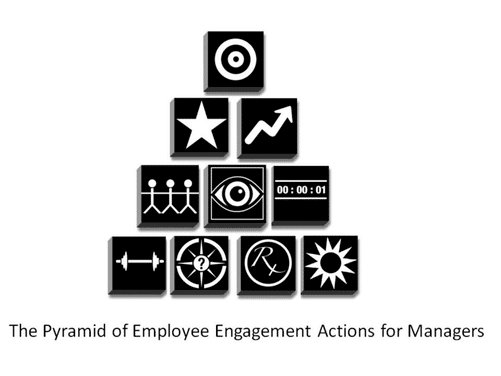3 Popular Employee Engagement Models That Work

If your company has a high turnover rate, it’s likely that you aren’t keeping your employees engaged with their work. As a result, you lose productivity and profits at the same time.
Fortunately, that’s where employee engagement theories come into play. These employee engagement models lay the necessary foundation for creating a more meaningful work environment.
From the name, an employee engagement model is a framework outlining how a company can keep its employees engaged. The point is to make them feel happy, satisfied, and valued.
Such engagement models treat employees as human beings who have lives outside the work environment.
Engagement models focus on the wellness of employees. Staff members who feel appreciated and valued in the workplace aren’t only less likely to quit; they're also more likely to be more productive.
Employee engagement model fundamentals
There are various employee engagement models out there, each with its own set of guidelines. As such, there’s no such thing as the best engagement model that will allow any company to thrive.
However, most of the models are based on the same pillars:
Having a reason to engage
Employees must have a reason to positively engage with their work establishment. Keep in mind that “engaging” doesn’t only mean coming to work every day. It also means finding a good work environment that can bring out the best in people.
Having the capacity to engage
Highly skilled employees who constantly try to improve themselves won’t stay in a work environment that makes them feel overqualified.
These employees need to be provided with the resources to improve, such as training, growth opportunities, and support from the management.
Having similar alignments
The employees must understand the mission and vision of the company. They shouldn’t feel like they’re simple cogs in a larger machine. Otherwise, there will be no growth or creativity, as employees who don’t look at the company as a whole would only focus on their personal tasks.
Now that we have a basic idea of what an employee engagement model is, let’s look at some examples:
The Zinger model of employee engagement

Zinger Employee Engagement Model 2024
Background
This model gets its name from its creator, David Zinger. He’s a management consultant who built a pyramid structure of employee engagement model blocks, thanks to his 25-year expertise in the field.
The best acronym to describe the Zinger modelOpens in a new tab is CARE, it stands for:
- Connection
- Authentic relationships
- Recognition
- Engagement
Theory
The Zinger model focuses on leveraging strengths, enhancing wellbeing, and enlivening energy.
In using your employees’ strengths, you must first be able to spot them. Play to employees' strengths, so to speak.
Being highly focused on the emotional aspect of the employees, the Zinger model is a great tool to help you find those strengths and take them to the next level.
You might also like: How to measure employee engagement effectively
Framework
The pyramid consists of 10 blocks, each representing a certain element that contributes to the outline of the pyramid.
The four blocks at the bottom represent strength, meaning, wellbeing, and energy. The following three blocks demonstrate recognition, relationships, and moments.
The upper two blocks are progress and performance, topped by the pyramid’s tip, representing the final results.
The higher we go up the pyramid, the higher the priority of the element. However, the more we go to the top, the more vital the lower elements will be as they directly affect the final element: the results.
The Zinger employee engagement strategy works by providing company leaders with 14 essential work strategiesOpens in a new tab. Some of these strategies are:
1. Esteem organization
Do your employees feel engaged with you and your company goals? Do they feel like they’re a part of the bigger picture?
If you don’t have a clear answer to those questions, you’ll need to incorporate the esteem organization strategy.
Disengaged employees won’t go the extra mile and are more likely to leave the company when given a better offer somewhere else. The Zinger model’s esteem alignment strategy will help you retain your employees.
2. Serving customers
Some employees have to serve the customers as it’s in their job description, but providing that seamless customer service experience can only come from a well-motivated employee.
The Zinger model focuses on providing the right motivation to employees so they will eagerly give more to customers.

3. Developing careers
The Zinger model prioritizes career development and internal company mobility. It’ll teach you, as an employer, how to spot, appreciate, and reward individual developments within your employees.
This will make your employees feel heard and noticed, keeping their motivation on optimal levels and aiding them to develop further and be promoted within the company.
4. Achieving results
It all boils down to results. If all the strategies were applied with hardly any results, then something must have gone wrong.
If applied correctly, the Zinger model strategies will elevate your employees’ mental condition, resulting in optimum performance.
The Deloitte engagement model

Background
FoundedOpens in a new tab in 1845 by William Welch Deloitte, the Deloitte modelOpens in a new tab has witnessed more than 175 years of growth and experience in business improvement.
The Deloitte model believes that employees now have more bargaining power than ever; and that keeping highly-skilled personnel has become a competition between leading companies.
Theory
Unlike the Zinger model’s focus on the emotional wellbeing of employees, the Deloitte model’s main goal is to create what they call “the simply irresistible organization.”
This model focuses on the company culture as a whole, providing various benefits in multiple fields, not just the emotional one.
Framework
Deloitte utilizes five engagement-driving elements, which are:
1. Meaningful work
Much like Zinger’s model concept, the Deloitte model highlights that employees tend to engage more if there’s a purpose for doing something.
To encourage this aspect, The Deloitte model provides employees with a sense of autonomy. Taking charge of their work allows them to have the freedom not only in creativity but also in creating meaning in their work.
2. Positive work environment
Employees are still humans; they also deal with complicated situations outside of their work lives. Deloitte makes sure to engage them by creating a safe and flexible space within the organization to ensure employee wellbeing.
High-pressure companies invest in giving employees various perks for staying. For example, companies introduce wellness programs. What makes this notable is that you’re encouraging employees to be their better selves even outside of work.
3. Hands-on management

Deloitte prioritizes hands on-management as it can boost performance, especially in larger teams.
Aside from that, the company shows its commitment to its people by investing in management development and practicing modern performance management.
With clear goals, your managers will likely stay within the targets. One way to do this is by implementing objectives and key results (OKR).
Hands-on management also improves when managers start coaching employees. That way, employees will begin to feel valued and show improved performance.
4. Growth opportunity
Employees tend to engage in their work more if they see growth opportunities in the organization. After all, no one will want to exert effort in something they see no future in.
Unfortunately, only 29% of employeesOpens in a new tab are happy with their current growth, which Deloitte aims to improve.
The model can promote growth by offering on-the-job support and training. This growth doesn’t only benefit the employee but also the company.
5. Trusting in leadership
Mission-driven organizations develop a strong sense of purpose. They also account for all stakeholders when defining success. As a result, people are happier in the organization.
Companies that invest in their peopleOpens in a new tab see a greater return. Not only do engaged employees thrive in the workplace more, but they also improve their levels of commitment. In doing so, they reduce their turnover rates.
Another crucial factor in building trust is transparency and honesty. Employees will feel involved when they’re constantly surveyed and heard.
Use
Each of the elements mentioned above has four underlying strategies, providing 20 strategies (compared to the Zinger model’s 14) to create a sense of engagement in the company.
Having more strategies and a bigger scope than the Zinger model doesn’t necessarily mean that Deloitte’s model is better.
It’s more of a functional suitability. Focusing more on the whole company culture than the emotional wellbeing makes the Deloitte model more suitable for large, well-established companies.
Deloitte has many clientsOpens in a new tab, but some of the biggest names are Microsoft, Metlife, and Boeing.
Gallup employee engagement model

Background
Gallup is an American analytics company founded in 1935 by George Gallup. As of 2017, the company has around 40 offices worldwide, making it a successful and reputable example to follow.
Gallup takes pride in providing useful statistics on employee engagement, including Gallup and Workhuman's employee recognition and wellbeing reports. So, it’s no surprise they formed their own model for improving employee engagement.
Theory
The Gallup employee engagement modelOpens in a new tab takes employee engagement and places it alongside the employee’s performance. The model focuses on whether the employee is capable of doing their job and whether their emotions at the time impact that performance.
The model also shows that improving employee engagement isn’t the HR division's job alone but rather a collaborative effort between managers, leaders, and HR members.
Framework

Five decades of research resulted in a 12-question engagement survey based on surveying millions of participants. In essence, each engagement question reveals any problems employees have in the workplace.
From the bottom, you’ll get a feel of whether the organization meets the employees’ basic needs. The statements for this row are:
- Q01: I know what is expected of me at work.
- Q02: I have the materials and equipment to do my work right.
When people agree with the first statement, they’re 2.5x more likely to be engagedOpens in a new tab than other employees who don’t agree.
Similarly, the second statement proves there’s no gap between employers and employees when trying to get the job done. After all, having all resources available makes it easier for people to perform well.
Next, the Q12 model assesses the employees’ contributions to the organization. It evaluates employees through these statements:
- Q03: At work, I have the opportunity to do what I do best every day.
- Q04: In the last seven days, I have received recognition or praise for doing good work.
- Q05: My superior, or someone at work, seems to care about me as a person.
- Q06: There is someone at work who encourages my development.
Much like the previous model, Gallup also emphasizes recognition. When many employees rate themselves higher on those statements, you show them that they’re irreplaceable. As a result, they’ll feel appreciated and valued as a person.
Once they have a good foundation for individual contributions, the Q12 determines teamwork strategies:
- Q07: At work, my opinions seem to count.
- Q08: The mission or purpose of my company makes me feel my job is important.
- Q09: My associates or fellow employees are committed to doing quality work.
- Q10: I have a best friend at work.
Based on the statements, teamwork consists of inclusion, mission, and purpose. These drivers reduce turnover rates in the workplace.
Additionally, employees will want to have colleagues who try hard as everyone else. It shows passion and commitment to empowering the team.
On the other hand, some people may raise an eyebrow at the 10th statement. However, having a best friend at work predicts performance since there’s a sense of strong affiliation across the team. Even the Zinger model promotes this connection.
Lastly, at the tip of the pyramid are growth statements.
- Q11: In the last 6 months, someone at work has talked to me about my progress.
- Q12: This last year, I have had opportunities at work to learn and grow.
Engaged employees put great value on professional growth, especially in the workplace. Employee engagement increases when you place the same importance on growth in the organization. That’s because people naturally have a knack for trying new things.
Use
Gallup’s model is highly flexible compared to Zinger and Deloitte. It can be used in most businesses regardless of size or market value.
Since it relies on a specific path of straightforward questions, it’s especially useful for remote or hybrid teams that may not meet frequently.
In summary
Implementing employee engagement models is crucial in continuously developing a company. Not only does it put your goals on track, but it also ensures that you value the wellbeing of all employees.
Looking at each model closely, they share the same principles in terms of inclusion, purpose, a positive work environment, and growth opportunities.
At the end of the day, it's important to remember that engaged employees drive successful business outcomes.